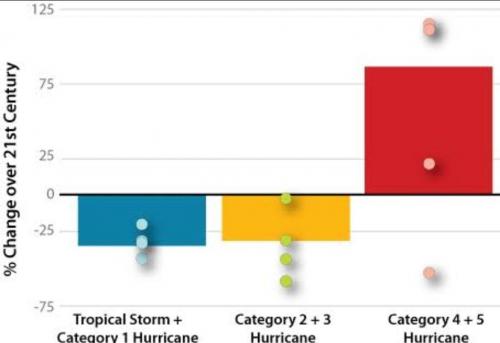Answers:
A. can be proven from the graph
B. cant be proven
C. can be proven
D. cant be proven
E. can be proven
F. can be proven)
Explanation:
The chart to be used to answer the question is currently missing. After obtaining online, I have attached it to this solution of this question.
From the graph, the prediction shows a negative percent change in the number of category 1 and category 2 & 3 hurricanes (greater than -25% change) and category 4 & 5 hurricanes get a positive percent change of more than +75% change)
Now, taking the statements, one at a time.
A. Which type of hurricane is expected to strike more frequently this century?
From the chart, only category 4 & 5 hurricanes are predicted to have a positive percent change in number, hence, they are the ones expected to strike more frequently in this century.
B) How are hurricanes formed in the atmosphere?
This information cannot be read off from the graph. So, the answer provided isn't from this chart of prediction.
Hurricanes are formed when warm, moist air from the ocean surface begins to rise rapidly, and they encounter cooler air that forces the warm water vapor to condense& form storm clouds with drops of rain.
C) In general, will hurricanes likely become stronger or weaker this century?
The less powerful hurricanes are predicted to have more than 25% negative percent change in number.
But the most powerful categories of hurricanes are predicted to have more than 75% positive percent change in number.
Although, the true figures aren't clear, but more hurricanes that happen are bound to be classified as category 4 & 5 hurricanes. It can be perceived that hurricanes are getting stronger in this century.
D) Which areas are at the highest risk of hurricanes?
This information cannot be read off from this chart. It isn't provided.
E) Which types of hurricanes are expected to drop in frequency by more than 25% this century?
From the chart, category 1 and category 2 & 3 hurricanes are predicted to drop in frequency by more than 25% this century.
F) How many category 4 and 5 hurricanes can we expect this century?
From the chart, we're predicted to have more than 75% positive percent increase in the number of category 4 & 5 hurricanes.
The number of category 4 and 5 hurricanes we should expect this century will be more than 75% higher than the previous century.

